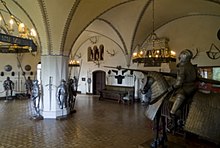Knight hall



Knight's hall is mostly the name for a large hall in a castle , a palace complex or a mansion , which is now often used as a ballroom or venue for concerts and exhibitions. It is occasionally used in the literature as a term for assembly and festival halls in monasteries or town halls .
The term only came up with the romantic castle in the 19th century, during the Middle Ages and in the early modern period the term was not yet common. It is based on the romanticized, transfigured notion that the knighthood of a sovereign came together for meetings and consultations in the largest room of a castle complex. Contrary to the actual sense of the word, knight halls usually have nothing to do with knighthood, and they are often used to designate halls .
The knight's hall in a castle
In fact, the hall-like main living room or the living hall of a castle is hidden behind the room called the knight's hall. The daily life of the castle residents took place there, for example eating meals, evening get-togethers, but also festivities and gatherings. These spaces were always on the top floor of a residential building - often with Palas called - or one room building to find and took them completely, or at least a majority one. With their long rows of windows, they were perhaps modeled on models such as the Asturian King's Hall of Oviedo , today's Santa María del Naranco Church . As an indispensable part of the court of a feudal lord , the size of these rooms largely determined the dimensions of a residential building.
A knight's hall usually had a beamed ceiling and floors made of clay or stone slabs. The enormous thickness of the walls made it possible to equip the niches of the mostly glassless windows with benches. For comfort, such halls had mighty chimneys, but their heating output was mostly insufficient, so that additional embers were set up as heat sources at low temperatures . The walls were mostly plastered and often painted . In the case of rich castle owners, the wall decoration of the knight's hall could also have gold inlays.
The knight's hall in other buildings
In the period of historicism , many halls in castle complexes were changed or restored in the neo-Romanesque and neo-Gothic styles . Especially in the palace building, many of the large ballrooms built in the Baroque era were redesigned into so-called knights' halls, whereby the design details were shaped by the romantic notion of the Middle Ages.
The same applies to meeting and ballrooms in monasteries. Abbots were also often secular princes. In order to fulfill their representative duties as a prince abbot or imperial prelate, they had large rooms in their home monasteries turned into ballrooms and accordingly lavishly executed. An example of such a knight's hall can be found today in the Benedictine Abbey of Iburg .
The naming of the halls in some council houses or parliament houses also ties in with the romantic idea of the knight's halls as a meeting place and meeting place . For example, the provincial estates met in the so-called knight halls in the Grazer Landhaus or the Arnsberg Old Town Hall .
In the area of Bündische youth work , expanded barns (elsewhere called the guest room of the youth tent site) are also referred to as the knight's hall, for example on the Allenspacher Hof in Böttingen .
literature
- Friedrich-Wilhelm Krahe: Castles and residential towers of the German Middle Ages . Volume 1. Thorbecke, Stuttgart 2002, ISBN 3-7995-0104-5 , p. 39.
- Otto Piper : Castle studies . Reprint of the 3rd edition from 1912. Weltbild, Augsburg 1994, ISBN 3-89350-554-7 , pp. 415-416.
- Manfred Reitz: Everyday Life, Feuds and Tournaments. Life in the castle . Thorbecke, Ostfildern 2004, ISBN 3-7995-0141-X , pp. 79-81.
- Barbara Schock-Werner : Knight's Hall. In: Horst Wolfgang Böhme , Reinhard Friedrich, Barbara Schock-Werner (Hrsg.): Dictionary of castles, palaces and fortresses . Philipp Reclam, Stuttgart 2004, ISBN 3-15-010547-1 , p. 215, doi: 10.11588 / arthistoricum.535 .
Web links
Individual evidence
- ↑ O. Piper: Burgenkunde , 1994, p. 677.
- ^ Friedrich-Wilhelm Krahe: Castles of the German Middle Ages. Floor plan lexicon . Flechsig, Würzburg 2000, ISBN 3-88189-360-1 , p. 44.
- ^ W. Krahe: Castles and residential towers of the German Middle Ages , 2002, p. 39.
- ^ W. Reitz: Everyday life, feuds and tournaments. Life at the Castle , 2004, pp. 79–80.
